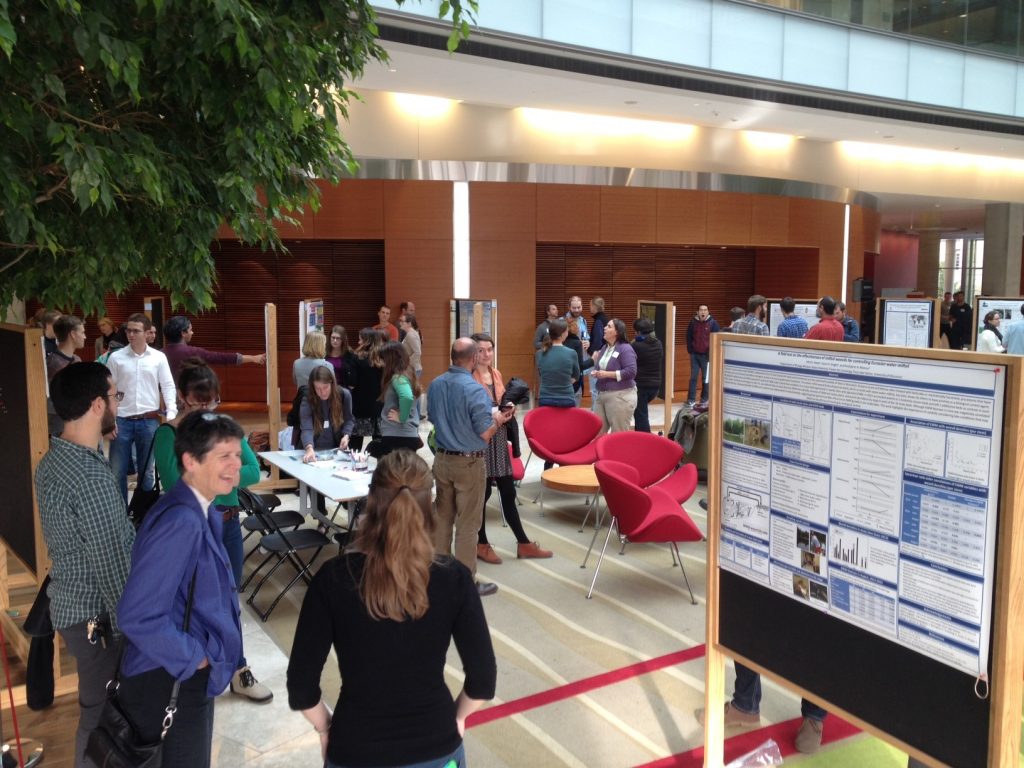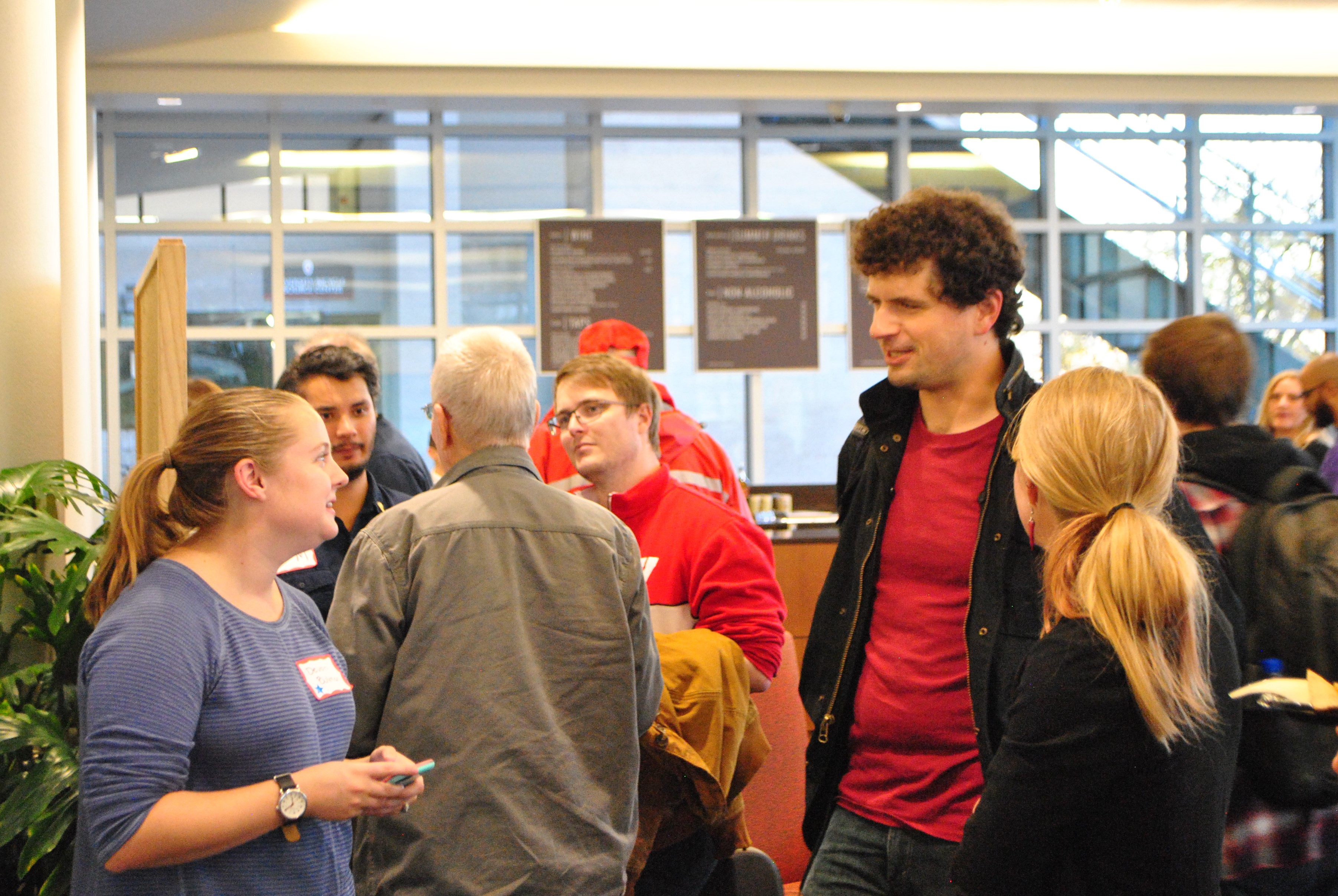 When: 4:00pm-6:00pm Wednesday, November 20, 2019
When: 4:00pm-6:00pm Wednesday, November 20, 2019
Where: Tripp Commons, Memorial Union
Event Details
Please join us for the annual Water@UW-Madison Fall Poster Session & Reception, a free event featuring research, art, and activities about water in the UW-Madison community. The event is free and open to the public (registration not required), and will include:
- Posters featuring the work of UW faculty, students, and water resource professionals
- Dr. Christy Remucal will discuss PFAS with “Per- and polyfluoroalkyl substances (PFAS) in the waters of Wisconsin”
- Refreshments and a cash bar
- Opportunities to network with people from all over the UW-Madison Water Community
Attendants at the Fall 2019 Poster Session & Reception
Attendants at the Fall 2019 Poster Session & Reception
Attendants at the Fall 2019 Poster Session & Reception
Dr. Ginder-Vogal giving a presentation
Dr. Remucal giving a presentation
Attendants at the Fall 2019 Poster Session & Reception
Attendants at the Fall 2019 Poster Session & Reception
Attendants at the Fall 2019 Poster Session & Reception
Attendants at the Fall 2019 Poster Session & Reception
Attendants at the Fall 2019 Poster Session & Reception
David Koser presents the photo contest winners
Attendants at the Fall 2019 Poster Session & Reception
Dr. Hauxwell's laboratory group
Anne Moser at the poster session
Attendants at the Fall 2019 Poster Session & Reception
Featured Posters
- Life Cycle Assessment of An Aquaponic Food Production System | Ramin Ghamkhar | Department of Civil and Environmental Engineering, University of Wisconsin – Madison
- Developing an Environmental Monitoring Plan to Minimize Legionella Risk on a University Campus | Jeffery Steele | Environment, Health and Safety, University of Wisconsin – Madison
- Wisconsin and Great Lakes Fellowships: Connecting Science, Policy, and Management | Adam Arend, Dr. Francisco Guerrero-Bolano, Dr. Carolyn Voter, and Dr. Ryan Lepak | Aquatic Sciences Center, University of Wisconsin – Madison; Wisconsin Coastal Management Program, Wisconsin Department of Administration; Wisconsin Department of Natural Resources; United States Environmental Protection Agency
- Lake-groundwater interactions of Plainfield, Long, and Pleasant Lakes in the Central Sands of Wisconsin under rising water level conditions | Mike Parsen, Dr. Catherine Hein, Dr. Carolyn Voter, and Aaron Pruitt | Wisconsin Geological and Natural History Survey, Division of Extension, University of Wisconsin – Madison; Wisconsin Department of Natural Resources
- Preservation, Collaboration, and Visualization: How a Book About Sturgeon Became an Experience | Morgan Witte and Anne Moser | Aquatic Sciences Center: Wisconsin Water Library and Wisconsin Sea Grant, University of Wisconsin – Madison
- Environmental Impacts of Single- and Multi-Walled Carbon Nanotube Synthesis Methods and Industry Based Large-Scale Impact Projections Using Life Cycle Assessment | Sila Temizel Sekeryan, Dr. Andrea L. Hicks, and Dr. Fan Wu | Department of Civil and Environmental Engineering, University of Wisconsin – Madison
- Riparian Forests in the Kickapoo Watershed: Differing Perspectives, Scientific Gaps, and Prospects for a Sustainable Future | Dr. Caroline Gottschalk Druschke, Dr. Eric Booth, and Emma Lundberg | Nelson Institute for Environmental Studies, University of Wisconsin – Madison
- Accelerated Growth and Doses of Ecological Death | Paul Hoppe and Gavin Dehnert | Department of Integrative Biology, University of Wisconsin – Madison
- Building Coastal Resilience in Southeastern Wisconsin | Lydia Salus, Dr. Adam Bechle, Julia Noordyk, and Dr. David Hart | Aquatic Sciences Center: Wisconsin Sea Grant, University of Wisconsin – Madison
- Spiny water flea and fish planktivory | Ben Martin and Dr. Jake Vander Zanden | Center for Limnology, University of Wisconsin – Madison
- The end-to-end value chain of Wisconsin’s statewide Landsat 7 ETM+ and Landsat 8 OLI-TIRS water clarity products | Dr. Daniela Gurlin and Steven R. Greb | Wisconsin Department of Natural Resources; Aquatic Sciences Center, University of Wisconsin – Madison
- Wisconsin Geological Survey Research Projects Story Map | Carol McCartney | Wisconsin Geological and Natural History Survey, University of Wisconsin – Madison
- Blueprint for Salt Sustainability on The UW Madison Campus | Abigail Ernst, Brittany Cobb, Brian Flynn, Wei (Chloe) Tang, and Michael Webber | Nelson Institute for Environmental Studies, University of Wisconsin – Madison
- Geochemical and geologic conditions associated with radium mobility in the Cambrian-Ordovician aquifer system | Marie Dematatis, Amy Plechacek, Madeleine Mathews, Dr. Daniel Wright, Florence Udenby, Dr. Madeline Gotkowitz and Dr. Matthew Ginder-Vogel | Department of Civil and Environmental Engineering, University of Wisconsin – Madison
- Reactivity of phenolic compounds with synthetic and reclaimed manganese oxides determined by organic and solid phase structural properties | Emma L. Trainer, Dr. Matthew Ginder-Vogel, and Dr. Christina K. Remucal | Environmental Chemistry and Technology Program, University of Wisconsin – Madison
- Effects of tillage and manure type on nitrogen and phosphorus losses through surface runoff from winter manure application | Laxmi Prasad, Dr. Anita Thompson, Dr. Francisco Arriaga, and Dr. Peter Vadas | Department of Biological Systems Engineering, University of Wisconsin – Madison
- Impact of Sediment Mercury Speciation on Mercury Cycling in the St. Louis River Estuary | Marissa Kneer, Amber White, Dr. Kristofer Rolfus, Dr. Jeff Jeremiason, Dr. Nathan Johnson, and Dr. Matthew Ginder-Vogel | Department of Civil and Environmental Engineering; Environmental Chemistry and Technology Program, University of Wisconsin – Madison
- Mapping Surface Soil Moisture at the 30-m Resolution at the U.S. Climate Reference Network Stations Using Sentinel-1 and Ancillary Data | Sumanta Chatterjee, Dr. Jingyi Huang, and Dr. Alfred E. Hartemink | Department of Soil Science, University of Wisconsin – Madison
- Isolation and isotopic determination of methylmercury in natural matrices using distillation pre-treatment coupled to anion-exchange chromatography | Tylor Rosera, Dr. Sarah Janssen, and Dr. James Hurley | Environmental Chemistry and Technology Program, University of Wisconsin – Madison
- Parasite community structure along a stream continuum | Landon Falke and Dr. Daniel Preston | Department of Forest and Wildlife Ecology, University of Wisconsin – Madison
- Dissolved organic matter transformation and halogenated product formation during chlorine photolysis | Devon Manley Bulman and Dr. Christina K. Remucal | Environmental Chemistry and Technology Program, University of Wisconsin – Madison
- Using stable lead isotope composition to track lead exposure in drinking water – are lead lateral lines the source? | Dr. Patrick Gorski, Dr. Sean Scott, Dr. Martin Shafer, and Dr. Jonathan Meiman | Wisconsin State Laboratory of Hygiene, University of Wisconsin – Madison
- Lab and field-based determination of microbial and photodegradation rates of 2,4-dichlorophenoxyacetic acid | Amber White, Dr. Christina K. Remucal, and Dr. Trina McMahon | Environmental Chemistry and Technology Program, University of Wisconsin – Madison
- Water Programming and Expertise in the Division of Extension’s Natural Resources Institute | Chad Cook | Division of Extension, Natural Resources Institute, University of Wisconsin – Madison
- Isotopic Examination of Photochemical Demethylation of Mercury in Natural Systems | Grace Armstrong and Dr. Sarah Janssen | Environmental Chemistry and Technology Program, University of Wisconsin – Madison
- The Hydroclimate Extremes Research Group at UW-Madison | Dr. Daniel Wright, Dr. Zhe Li, Guo Yu, Samantha Hartke, Christopher Bosma, Camila Abe, and Yihan Li | Department of Civil and Environmental Engineering, University of Wisconsin – Madison
- National Water Dance Project | Karen McShane-Hellenbrand | Dance Department, University of Wisconsin – Madison
- Calcium isotopes as a proxy for nutrient load in the Yahara River Watershed | Dr. Sean R. Scott, Gage Hunter, Dr. Francie Rowe | Wisconsin State Laboratory of Hygiene, University of Wisconsin – Madison
- Investigating Biogeochemical Factors Impacting Manoomin Propagation and Survival in Wisconsin with Culturally-Relevant Practices | Sarah Dance | Environmental Chemistry and Technology Program, University of Wisconsin – Madison
- Microbial Ecology of Freshwater Lakes and Engineered Wastewater Systems | Krystyn Kibler and Benjamin D. Peterson | Environmental Chemistry and Technology Program; Freshwater and Marine Sciences, University of Wisconsin – Madison
- Microbially-Mediated Pyrite Oxidation at Circumneutral pH in Sandstones of Trempealeau County, WI | Lisa Haas, Dr. Eric Roden, Dr. Matthew Ginder-Vogel, Dr. Jay Zambito | Department of Geoscience, University of Wisconsin – Madison
- Pricing water in energy market models | Jiajie Shen | Department of Industrial and Systems Engineering, University of Wisconsin – Madison
- Loheide Hydroecology Lab | Dominick Ciruzzi | Department of Civil and Environmental Engineering, University of Wisconsin – Madison
- Microbially-Mediated Weathering of Minerals in the Central Sands | Allison Hartman | Department of Geoscience, University of Wisconsin – Madison
- Tree rings reveal drought avoidance through groundwater usage and historic groundwater variation in sandy temperate forests | Dominick Ciruzzi and Dr. Steven Loheide | Department of Civil and Environmental Engineering; Department of Geological Engineering, University of Wisconsin – Madison
- Fairy Rings of the Huron Mountains | Dr. Susan Knight and Carol Warden | Center for Limnology, University of Wisconsin – Madison
- Building a Data Science capability for USGS water research and communication | Dr. Jeffrey Sadler, Dr. Alison Appling, Dr. Samantha Oliver, Lindsay Platt, Dr. Jordan Read, David Watkins, and Dr. Jacob Zwart | United States Geological Survey
- Amphibian communities in human modified landscapes: Are stormwater ponds oases or ecological traps? | Dr. Erin Sauer | Department of Forest and Wildlife Ecology, University of Wisconsin – Madison
- Watershed Engineering and Management Research Group | Dr. Anita Thompson, Rachel Johnson, Yi Wang, Yu Li, Dr. Edward Boswell, Laxmi Prasad, Xi Chen, Laura Bates, and Kelsey Kruger | Department of Biological Systems Engineering, University of Wisconsin – Madison
- Evaluating links between algal blooms and CO2 and CH4 fluxes | Adam Rexroade | Center for Limnology, University of Wisconsin – Madison
- Design and Development of a Cost-Effective, Open-Sourced Water Temperature Sensor String | Kevin Gauthier | Center for Limnology, University of Wisconsin – Madison
- Role of Pinhole Defects in Enhancing Water Transport through Graphene Oxide Laminates | Frederick (Songying) Li, Vivek Saraswat, Robert Jacobberger, Joshua Ostrander, Courtney Hummell, Austin Way, Jialiang Want, Martin Zanni, and Michael Arnold | Department of Materials Science and Engineering, University of Wisconsin – Madison
- Wisconsin’s Watershed Leadership in the Mississippi and Atchafalaya River Basin | Anne Marie Nardi and Rebecca Power | Division of Extension, University of Wisconsin – Madison
- Understanding river ecology and informing restoration: long-term monitoring and research on the Upper Mississippi River | KathiJo Jankowski | Upper Mississippi River Restoration Program, United States Army Corps of Engineers; United States Geological Survey
For Presenters: Poster Requirements
 All posters must meet the following requirements:
All posters must meet the following requirements:
- Poster dimensions no larger than 48″x 48″
- Boards for mounting will be provided at the event
- The mounting of the display must be able to be completed by 3:40 pm and remain up until 6 pm on the day of the event*
- During the poster session, one person must remain at the display to answer questions or engage attendees on the contents of the display
- The poster should present information in a visually appealing way and be accessible to a general audience
- No vulgar, explicit, or otherwise inappropriate content, please
- Please note outlets may not be available, if you want to use a laptop it will need to run off the battery
* Detailed information on poster set-up and location at the event will be sent to you following approval of your abstract. If you cannot stay to remove your poster between 6 pm and 7 pm, we will do that for you and store it at the Center for Limnology where you can pick it up later that week.